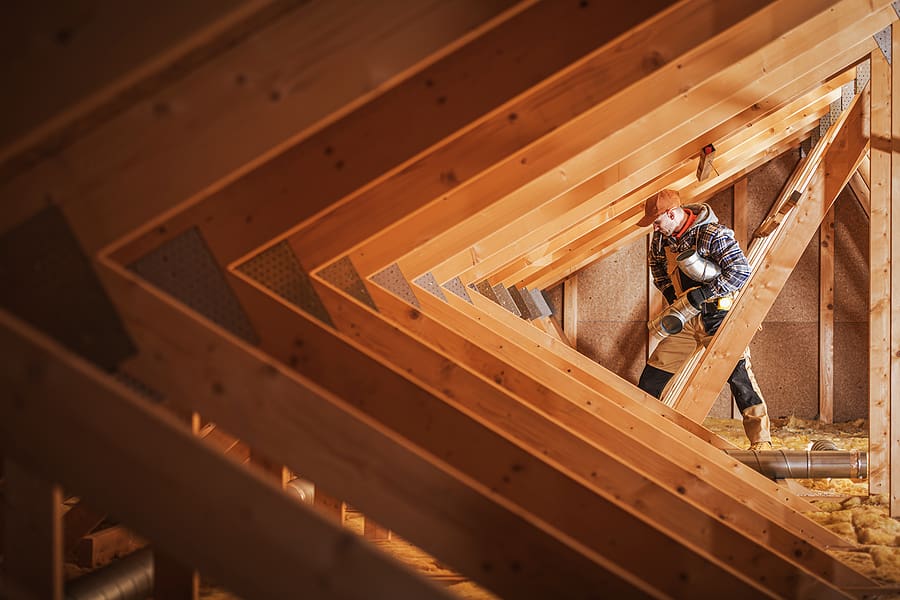Proper Roof Ventilation Can Save You Money and Extend Roof Life
Most homeowners are not familiar with their roof. They know it’s there, has shingles, protects their family from the elements, and may affect their energy bills, but beyond that, they rarely think about the details. It’s not until there’s a problem that most homeowners must consider everything that goes into their roof, including replacement and repair. One of the most important aspects of an efficient and healthy roof is proper roof ventilation. A properly ventilated roof will not only save money but also extend the life of your roof.
What is Roof Ventilation?
Simply put, roof ventilation refers to the movement of air. When air is trapped and your home can’t breathe, its health will suffer, heat and moisture will build up, and this can cause major issues like mold growth, wood rot, and structural damage. To keep heat and moisture from building up and causing these problems, air needs to be able to move. Roof ventilation consists of two types of vents: intake vents and exhaust vents. These vents will be strategically placed on your roof and in your attic. Intake vents allow air to move into your attic space, and exhaust vents will move the air out. Your roofing contractor can help you determine how much ventilation you need for your home, as smaller attics have different needs than larger attics, and your ventilation should be tailored to your home.
The Importance of Temperature Regulation
If you live in a region with hot summers and cold winters, you understand the importance of temperature regulation. However, many new homeowners assume a well-insulated house will be completely sealed to keep hot or cold air out. While an insulated and sealed house is essential for temperature regulation, especially around doorways, windows, and walls, ventilation in the roof and attic will help regulate the temperature of your home, put less strain on your heating and cooling systems, and keep your house more efficient. The airflow balance will help remove stale air and works as a free thermostat year-round, keeping your home cooler in the summer and protected from ice dams that can cause serious structural damage in the winter.
Roof Ventilation Prevents Moisture Buildup
When air flow is reduced, moisture can build up. Think about how stuffy a closed room or storage space can be when there is nowhere for the air to go. Trapped air leads to a buildup of humidity, and humidity creates the perfect growth environments for mold, mildew, and rot – three things you do not want in your home. Mold, mildew, and rot can cause your home to smell, cause serious health concerns as the spores make their way into your living spaces, and break down your home’s structure if they are allowed to grow and spread unchecked. The longer these three hazards are allowed to fester, the worse the damage will be, and the worse the damage, the more expensive it will be to repair. It’s not just a “good idea” to increase air flow to reduce moisture buildup; keeping your home healthy and safe is necessary.
A Well-Ventilated Roof Lasts Longer
A roof can be expensive to repair or replace. Most homeowners assume they’ll need to invest in their roof every twenty years, but any more than that can be a real burden. If your roof is not well ventilated, the extreme temperatures and moisture buildup won’t only have consequences in your attic, but will also strain your roof itself, causing materials to break down more quickly. If your roof is not well ventilated, the shingles will break down much more rapidly, but damage that can come from unregulated temperatures is even more concerning. For example, a poorly ventilated roof is prone to ice dams. During the winter, snow can partially melt, either due to the sun or because it’s sitting in a warm attic. When the melted snow refreezes overnight or during a cold snap, it creates blockages. These blockages cause water to back up under your roof shingles and eat away at the underlayer of your roof, and this can cause leaks and damage. A damaged underlayer of your roof will not only necessitate a replacement much more quickly than average, but will also be more expensive to replace.
How Do I Know If My Roof is Well-Ventilated?
So, how do you know if your roof is well-ventilated? Do you need to install more vents or fans? To determine if your ventilation is up to the task, look for signs of insufficient airflow. While all attics can feel hot in the summer, make it a point to check and see if the air in your attic is excessively hot and feels stale. Trapped heat in your attic indicates insufficient ventilation. You may also notice that your roof shingles are beginning to curl, paint may start to peel, or your home feels excessively humid. If you think there may be a problem with your ventilation, it may simply be that one of the vents is blocked by debris, or you may need to install additional vents. If you suspect your ventilation system needs help, you can have it inspected by a trusted roofing contractor.
Inadequate ventilation is a problem that shouldn’t be ignored. Trapped air may not sound like a crisis, but if ignored, you can quickly allow a minor issue to grow into a big one. A properly ventilated roof will not only allow your roof to last longer, but it will also put less stress on your heating and cooling systems, ensure a healthy environment for your family, and keep your home structurally sound.
If you’re unsure about your roof’s ventilation, All-Nu Construction is here to help. Contact us today to schedule an inspection—our professionals will assess your system and recommend the best solutions to protect your home and extend the life of your roof.

